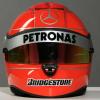
When is it ok to make motorsport more dangerous?
#1

Posted 22 July 2015 - 20:27
But some people want more gravel traps to punish drivers, or more walls of champions. They want faster cars and refuelling, cars closer together with more battles and overtakes, more wet weather running and and harder to control cars in general. The FIA are in the process of implementing (or attempting to at least) some of these things right now.
Do you think this is acceptable and what situations do you find increased danger acceptable?
Advertisement
#2

Posted 22 July 2015 - 20:33
#3

Posted 22 July 2015 - 20:42
My personal opinion has always been that you either take care of risk or you take care of danger. And that they're slightly different.
The FIA/F1 makes it really really hard to hit something with the racecar. If I was going to crash on any track I'd want it to be an F1 track. Odds are you're just going to spin to a stop somewhere.
Indycar accepts you're going to crash and you're going to hit something. So they put the best safety response around it(their medical teams, their doctors, they were the first to really do HANS, etc). So if I was going to crash and hit something I'd rather have it happen on an Indycar track. There have been several accidents in Indycar in, say, the last 20 years that I don't think would have been survivable within an F1 weekend(assuming it was on the same track).
If that makes sense...
And for anyone surprised/outraged at the idea of F1 not having the best safety in the world, think how much time it takes the medical car to get to a crash. Now think about how quickly they're there in Indycar racing. The first responders in Indycar are way better equipped and distributed, and there's more of them, than in F1.
#4

Posted 22 July 2015 - 20:57
I presume you mean F1 for risk and Indy car for danger, but don't they both really equate to the same thing, risk of danger?
#5

Posted 22 July 2015 - 21:02
I think F1 tries to eliminate the risk of hitting something. Indycar looks at the danger that occurs when you do.
In my world of logic and grammar.
Edited by Ross Stonefeld, 22 July 2015 - 21:02.
#6

Posted 22 July 2015 - 21:07
Gravel traps need to return. I don't really care if asphalt run-offs make things MARGINALLY safer (do they really?), but these huge penalty-free runoffs have got to go.
#7

Posted 22 July 2015 - 21:09
My personal opinion has always been that you either take care of risk or you take care of danger. And that they're slightly different.
The FIA/F1 makes it really really hard to hit something with the racecar. If I was going to crash on any track I'd want it to be an F1 track. Odds are you're just going to spin to a stop somewhere.
Indycar accepts you're going to crash and you're going to hit something. So they put the best safety response around it(their medical teams, their doctors, they were the first to really do HANS, etc). So if I was going to crash and hit something I'd rather have it happen on an Indycar track. There have been several accidents in Indycar in, say, the last 20 years that I don't think would have been survivable within an F1 weekend(assuming it was on the same track).
If that makes sense...
And for anyone surprised/outraged at the idea of F1 not having the best safety in the world, think how much time it takes the medical car to get to a crash. Now think about how quickly they're there in Indycar racing. The first responders in Indycar are way better equipped and distributed, and there's more of them, than in F1.
You are probably right, but just out of curiosity, what accidents are you referring to?
#8

Posted 22 July 2015 - 21:11
Everybody agrees that we should make motorsport safer.
But some people want more gravel traps to punish drivers, or more walls of champions. They want faster cars and refuelling, cars closer together with more battles and overtakes, more wet weather running and and harder to control cars in general. The FIA are in the process of implementing (or attempting to at least) some of these things right now.
Do you think this is acceptable and what situations do you find increased danger acceptable?
If a sport knowingly increases the risk of career ending injuries or death on behalf of its participants (and that includes drivers, pit crew, marshals), then I'd assume it was a negligent governing body. More to the point, increasing the risk of maiming or death purely to improve the show is as artificial as DRS and even more reprehensible, morally.
But you're assuming that they're mutually exclusive, and they're not really.
It is possible to build a harder to control car that's safer. You just improve the safety of the car proactively so the overall risk of chance of accident + consequences of accident are less than they were before. So, if you have a harder to control car on a track with acres of run off and reduce the numbers of cars on track, say, then you're overall safer because while the chances of mistakes increase the chances of serious consequences decreases. You can invest money in improving materials used, or in safety generally to keep the general safety the same while making the sport more difficult, and I guess it's a case of compromise around what any individual wants as to what gets swapped in for what.
Of course, there's always the people that want a sport as safe as the 2000s with no engines blowing up but the actual cars of the 70s (whose engines blew up constantly), and the speed of the 80s but not slower than today, and the heroes like Prost and Senna who never fuel saved or looked after their tyres because they steered with their excessively large testicles - and those people need to actually watch some of the Grands Prix they're talking about.
#9

Posted 22 July 2015 - 21:24
If a sport knowingly increases the risk of career ending injuries or death on behalf of its participants (and that includes drivers, pit crew, marshals), then I'd assume it was a negligent governing body. More to the point, increasing the risk of maiming or death purely to improve the show is as artificial as DRS and even more reprehensible, morally.
So any change for entertainment purposes that has side effect of more danger is off limits then?
#10

Posted 22 July 2015 - 21:26
I think you are leaning towards Sprinting or maybe Time-AttackIf a sport knowingly increases the risk of career ending injuries or death on behalf of its participants (and that includes drivers, pit crew, marshals), then I'd assume it was a negligent governing body. More to the point, increasing the risk of maiming or death purely to improve the show is as artificial as DRS and even more reprehensible, morally.
But you're assuming that they're mutually exclusive, and they're not really.
It is possible to build a harder to control car that's safer. You just improve the safety of the car proactively so the overall risk of chance of accident + consequences of accident are less than they were before. So, if you have a harder to control car on a track with acres of run off and reduce the numbers of cars on track, say, then you're overall safer because while the chances of mistakes increase the chances of serious consequences decreases. You can invest money in improving materials used, or in safety generally to keep the general safety the same while making the sport more difficult, and I guess it's a case of compromise around what any individual wants as to what gets swapped in for what.
Of course, there's always the people that want a sport as safe as the 2000s with no engines blowing up but the actual cars of the 70s (whose engines blew up constantly), and the speed of the 80s but not slower than today, and the heroes like Prost and Senna who never fuel saved or looked after their tyres because they steered with their excessively large testicles - and those people need to actually watch some of the Grands Prix they're talking about.
#11

Posted 22 July 2015 - 21:29
But you're assuming that they're mutually exclusive, and they're not really.
It is possible to build a harder to control car that's safer. You just improve the safety of the car proactively so the overall risk of chance of accident + consequences of accident are less than they were before. So, if you have a harder to control car on a track with acres of run off and reduce the numbers of cars on track, say, then you're overall safer because while the chances of mistakes increase the chances of serious consequences decreases. You can invest money in improving materials used, or in safety generally to keep the general safety the same while making the sport more difficult, and I guess it's a case of compromise around what any individual wants as to what gets swapped in for what.
Can i take this to mean you think safety in the sport is absolutely perfect as is and should somehow be guesstimated to keep it at this level?
Edited by Tapz63, 22 July 2015 - 21:31.
#12

Posted 22 July 2015 - 21:37
Everybody agrees that we should make motorsport safer.
But some people want more gravel traps to punish drivers, or more walls of champions. They want faster cars and refuelling, cars closer together with more battles and overtakes, more wet weather running and and harder to control cars in general. The FIA are in the process of implementing (or attempting to at least) some of these things right now.
Do you think this is acceptable and what situations do you find increased danger acceptable?
Gravel traps generally punish drivers with a retirement, it's not that often that they cause a real increase in danger/higher risk of death etc though. As for more wet weather running, harder to control cars, faster cars etc, of course implementing those sort of things to maybe increase the number of closer battles etc is acceptable, otherwise you may as well be like Nascar when it comes to not racing in even damp conditions and may as well just have a mandated speed limit and mandated gap between each car if you want them slower and not having close battles. Basically you may as well just ditch motorsport altogether using your apparent feelings that the changes in the pipeline are wrong for safety/danger.
Edited by HuddersfieldTerrier1986, 22 July 2015 - 21:37.
#13

Posted 22 July 2015 - 21:47
I think there has to be an element of risk, of danger, involved. For me, motorsport needs to amaze you on lots of different levels. You should feel like the guys behind the wheel are doing something really special, and if there was no element of risk involved at all, it'd be kind of like...well, 'so what? Anyone can do that.' Would extreme sports have the same appeal if there was no element of 'what if something goes wrong now'? I don't think they would.
Put it another way. You don't get the same buzz from watching sim racing as you do when you're at the side of a track.
Also, on a different note, I think an element of danger encourages better driving. We've seen various incidents of haphazard driving in junior categories over the years, from kids who've grown up in super strong cars, on super safe tracks where it is impossible to hit anything a lot of the time like Ross said, and think they're invincible. Maybe, if any good is to come out of the Bianchi situation, it will be a realization that if something like that can happen in F1, then it can happen anywhere.
That's very macabre thought, I know. But let me make it clear - I do not want to see anyone killed or seriously injured. But this current era of Tilkedromes does little to really help the sport. They don't demonstrate the true ability of the guys in F1. That's why I've come to appreciate something like oval racing more and more over the years. On an oval, if you make a mistake, it's normally a one way ticket to the wall. Similar story with rallying, or road racing. Arguably, there's more skill involved in oval racing, rallying and road racing than there is in driving an F1 car around a Tilkedrome. But perhaps I've gone off topic a little bit here. ![]()
Edited by JHSingo, 22 July 2015 - 22:03.
#14

Posted 22 July 2015 - 21:51
Ever.
#15

Posted 22 July 2015 - 21:59
Huddersfieldterrier:
"Gravel traps generally punish drivers with a retirement, it's not that often that they cause a real increase in danger/higher risk of death etc though."
Gravel traps usually ends in retirement, and a tractor being on the side of the track usually ends in a car being recovered. I didn't see gravel as a main cause of accidents and injuries either but apparently they were/are.
I shouldn't equate gravel traps with a tractor really I know, but both require a very unfortunate and rare occurrence to cause death or injury on a race track don't they?
Edited by Tapz63, 22 July 2015 - 22:02.
#16

Posted 22 July 2015 - 22:04
I would like to see the reinstallment of some gravel traps. Quite a lot of them, actually, particularly at the exit of corners to create a natural track limit. I guess it could make things more dangerous; there would be more gravel on the track and more retired cars to recover, and possibly more spins and damaged cars that slowly try to make it back to the pits. And gravel can cause a car to roll. On the other hand, with tarmac runoffs throughout the corner you tend to get cars rejoining the track at higher speed, like Gutiérrez at Stowe Corner three years ago (yes, he ran out of tarmac at the very end).
Is it acceptable to ask for more gravel? I don't know. Ask the GPDA.
#17

Posted 22 July 2015 - 22:11
Do you think this is acceptable and what situations do you find increased danger acceptable?
I don't think in the modern day and age anybody is advocating the introduction of danger for it's own sake. Some people want things (re)introduced which may increase danger in certain circumstances, but not for the sake of danger.
#18

Posted 22 July 2015 - 22:31
It depends on what context we're talking about. In terms of drivers we'd never want them to hurt themselves. In terms of sports that is a field of entertainment danger, drama and spectacular crashes have significant role. Of course you can not have both unless you replace the drivers with computers, so there has to be a trade-off between safety and danger which gets determined by each generation.
If you go too far with danger, you lose the drivers. If you go too far with safety, you lose the excitement.
There's also a big difference whether something is dangerous and whether something is a challenge. For instance the wall of the champions is hardly dangerous corner, yet it's challenging (or used to be). Wet racing is great because it's more challenging, though there's also an element of danger with heightened risk of loosing control. Another trade-off there.
After season 2000, I think FIA has been somewhat thoughtless with their stance how to make racing safer. Gravel traps were never that big of a risk factor (9/10 times car would just beach it) and the tendency to replace the gravel even from the slowest corners is beyond me. Another unfortunate cost of this sterilization is that the decreased level of excitement affects all the other racing classes that race on the European tracks. I'd like to see the challenge being restored on many tracks, like we have in American racing. Just what kind of challenge Abu Dhabi could offer with gravel traps? That would be an interesting idea at least.
Edited by Ruusperi, 22 July 2015 - 22:38.
#19

Posted 22 July 2015 - 23:03
There should be better wet weather tyres to deal with heavier rain and gravel traps need to come back and replace tarmac run-offs. I don't think gravel traps are particularly dangerous, although i think there are the odd place throughout the season where they aren't appropriate e.g. Belgium where Burti crashed. Better wet weather tyres would partly make racing to a degree safer as cars would not be running through heavy rain, however if they didn't exist like they currently do not then they wouldn't run at all. However, it would also mean more racing in high spray which wouldn't be ideal. Nonetheless, although I don't want drivers to be hurt, if the sport dies because fans turn off because the racing becomes stale and there is little punishment for making a mistake, then I think drivers would prefer to do what they love with slightly more risk, than not do it at all.
Advertisement
#20

Posted 22 July 2015 - 23:42
#21

Posted 22 July 2015 - 23:53
I certainly wouldn't want to make things more dangerous. But there's a difference between danger and a driver risking his race. You don't necessarily have to make it dangerous for going off the track to mean that you lose more time or potentially put yourself out of the race. And when people moan about F1, I don't think the complaint is generally that drivers aren't taking as many risks with their lives, but that going off simply means going over a painted line onto another part of the over-sized car park that they're racing on.
I kind of agree with this. Risking your finishing position doesn't necessarily mean you have to risk your life, and it's possible to have it both ways. The idea that it's a stupid 'Sport can be boring or drivers can die' mutually exclusive choice that somehow has to be made is ridiculous.
#22

Posted 23 July 2015 - 00:58
without real danger there can not be real heroes. with all those safety rules current F1 is like playing Hamlet without any of the cast getting hurt. (Polonius gets 10 spot grid penalty etc.)
dunno why, but (western?) people somehow do not want accept death as a natural part of life.
#23

Posted 23 July 2015 - 01:01
When the sociopaths who oppose any safety measures are forced to drive.
#24

Posted 23 July 2015 - 01:45
Here is Dr John Hinds talking about Irish Road racing and how well prepared they are to tackle accidents.
Sadly he died a few weeks ago in Practice.
#25

Posted 23 July 2015 - 03:22
There are always instances with freak accidents that it clouds how dangerous a sport should be or how safe a sport is. I would say sure okay, lets go back to how they would race in really wet tracks, where there would be danger of crashing hence associated minor injuries. But avoiding major injuries/death is such a grey area, how you going to judge when something like Bianchi's death? Let me say it was a freak accident. But everybody needs to wake up and be extra careful. Maybe drivers/teams/marshals need to be penalised heavily in instances like these.
#26

Posted 23 July 2015 - 03:47
Never. You don't see people adding invisible traps to the 100m dash.
Making the sport safer is entirely different from eliminating the consequences from driver errors or miscalculations.
Edited by Atreiu, 23 July 2015 - 03:50.
#27

Posted 23 July 2015 - 03:53
I don't think in the modern day and age anybody is advocating the introduction of danger for it's own sake. Some people want things (re)introduced which may increase danger in certain circumstances, but not for the sake of danger.
I understand that, just want to find out in what circumstances people feel it is ok.
#28

Posted 23 July 2015 - 11:28
In general, while improving safety is important, it shouldn't happen at the expense of challenge. SAFER Barrier is a great example on that. It doesn't forgive spinning but it reduces its consequences. A paved runoff may reduce the consequences of spinning even more but a corner loses its challenge.
#29

Posted 23 July 2015 - 14:28
I agree fully that something has to happen to the runoff areas. The gravel trap was not dangerous for drivers having a spin or miscalculating their braking points. But it was dangerous for cars where something broke and they were then hitting the first part of the gravel and went airborn, meaning they didn´t loose any speed before impact. That is why I had written in a different post that something has to change without endangering out of control cars. I do not know the answer but I am convinced that it is worth investigating heavily.
#30

Posted 23 July 2015 - 14:57
Pushing a Formula 1 car to the limit and keeping it within the white lines should be an art form, push too hard, run wide and off the circuit and you're punished.
We don't have that (with the exception of Monaco and a few other corners), we have drivers just pushing harder and wider and then suddenly too wide too fast and they just keep their foot down and steer back onto line. Like it was nothing.
Walking along a tight rope 6ft in the air has danger, you could fall off and land in a heap.
Walking along a chalk line drawn on the ground isn't exciting, there's no risk. That's where F1 generally is right now.
Of course I'm not talking huge accidents, I'm referring to mistakes and going wide of the track.
#31

Posted 23 July 2015 - 15:37
I don't care about the danger factor in terms of people getting hurt. Doesn't add anything for me, and will cause only suffering to people.
However, I do care about driving challenge. Which basically means run-off areas, which are made of gravel and/or grass. But also for example kerbing or track lay-out. But for me this has nothing to do with danger as such.
#32

Posted 23 July 2015 - 16:08
There is a fine line between getting rid of rosk and making mistakes be panalised more.
I detest watching cars making massive errors that should be penalised with a trip through gravel, and instead they just bump over some grasscrete.
It is taking skill and ability away from drivers and making it less obvious who is doing a good job.
While tracks ike Monaco reward that type of driving, some of thema re a joke.
But if you bring it back, potential incidents will result in more injuries probably.
You can'ty win
I am just thankful I was around to witness proper motorsport when fans could get close, drovers could show you why you cheered for them.
#33

Posted 23 July 2015 - 16:33
Making any racing more dangerous? No, unconscionable.
Making it so that mistakes are penalized, yes.
#34

Posted 23 July 2015 - 16:49
So any change for entertainment purposes that has side effect of more danger is off limits then?
I said knowingly. If you're adding something in for entertainment purposes then it's difficult to know what effect it'll have. If you take DRS as an example. It hadn't been used in F1 before. There's no obvious reason why they would increase injury or death (they increase top speed and reduce drag, but if a driver touches the brakes then that's eliminated). But if the FIA had data from other series saying yes, DRS increases the risk of serious injury by 50% or 100% you think they'd have introduced it?
Can i take this to mean you think safety in the sport is absolutely perfect as is and should somehow be guesstimated to keep it at this level?
No, I think safety should be constantly evolving, constantly reviewed and constantly improved. I think that every time a driver has a crash whether there's injury or not there ought to be a little dataset somewhere in the FIA that logs it and all the information that they can from it. I think that if some bright spark wants to do a research project into which medium-speed corner of an FIA Grade 1 track produces the most injuries and why that happens the data ought to be sat there waiting to be analysed.
This is a sport where data and data analysis is king and I think it's madness that people can throw out statements like "well, gravel isn't much more dangerous than run off" and there's not a good study out there (that I can find using google scholar) that even compares the two. In an ideal world, there'd be a huge dataset available for PhD civil engineering students and statisticians to look at what's best, and there'd be FIA grants to encourage them to do that. I think there is, as of one or two years ago, a motorsport medicine grant. It seems mad that there's a huge FIA Road Safety Grant scheme on the roll, and barely anything for track safety.
Even if the data is just analysed and sat there and only brought out after an accident to be asked 'how can we stop this happening again?'
In an idea world, when someone says "well, gravel can't be much worse than run off", there'd be four or five studies comparing hospitalisation across FIA (and hopefully FIM) sports, and deaths, and over what time period, and number of crashes in that time, and what the average speed reduction of gravel vs run off is per metre, and perhaps a few studies suggesting other materials that haven't been used before, because the internet seems convinced in that debate that we either have what we've got now or we go back to a previous material, and there ought to be a few civil engineering students who could think outside the box.
And then people could go "yes, you're right, one extra non intensive hospitalisation every 10,000,000 km of FIA Grade 1 circuit motorsport isn't actually that bad, and it looks like if you widen the gravel by 5 metres or even if you change the material or shape of this bit of the survival cell, the risk stays exactly the same". But I think that's the level of data that's needed and frankly I don't see why it's not publicly available (obviously not with medical details).
Safety isn't what attracted anyone to motor racing.
Ever.
But how many people has actual death driven away? I can think of a few people within my family who stopped watching post-Senna because they had no interest in ever watching a man die for sport again.
#35

Posted 23 July 2015 - 17:15
I said knowingly. If you're adding something in for entertainment purposes then it's difficult to know what effect it'll have. If you take DRS as an example. It hadn't been used in F1 before. There's no obvious reason why they would increase injury or death (they increase top speed and reduce drag, but if a driver touches the brakes then that's eliminated). But if the FIA had data from other series saying yes, DRS increases the risk of serious injury by 50% or 100% you think they'd have introduced it?
What do you think about the proposed speed increase for example then? It obviously won't increase risk by 50% but will certainly push it up some.
#36

Posted 23 July 2015 - 17:22
Everybody agrees that we should make motorsport safer.
But some people want more gravel traps to punish drivers, or more walls of champions. They want faster cars and refuelling, cars closer together with more battles and overtakes, more wet weather running and and harder to control cars in general. The FIA are in the process of implementing (or attempting to at least) some of these things right now.
Do you think this is acceptable and what situations do you find increased danger acceptable?
Increase the risk of increasing your laptime or DNF for not being able to keep it on track, not the danger of getting injured. There is a difference.
#37

Posted 23 July 2015 - 17:33
Increase the risk of increasing your laptime or DNF for not being able to keep it on track, not the danger of getting injured. There is a difference.
Because that is so difficult to do any other way right?
Gravel is dangerous. Drivers have through the GPDA made efforts and succeeded to have it removed directly on their behalf on occasion because of safety. Nobody wants to see people get hurt or killed.
#38

Posted 23 July 2015 - 17:47
But how many people has actual death driven away? I can think of a few people within my family who stopped watching post-Senna because they had no interest in ever watching a man die for sport again.
Ironically, F1 saw a considerable upswing in viewing figures in the immediate aftermath of Imola '94.
So what does that tell us? That the world is full of blood thirsty people? ![]()
Like I said before, I don't think anyone wants to see people seriously injured or killed. Only the most deranged would say they did. But there is definitely an appeal for sports in which the activity does involve risk. I guess, in some ways, that's why a company like Red Bull (who are prolific in their support of extreme/risky sports) entered F1.
#39

Posted 23 July 2015 - 18:00
What do you think about the proposed speed increase for example then? It obviously won't increase risk by 50% but will certainly push it up some.
I think it probably won't happen so I've not really thought about it? I think that cars lapping at 5 seconds faster with the same deficits between teams will probably look no different to what we have this year because a difference of 5 seconds over a 90 second lap is probably inperceptible to the human eye and camera angles are more important. (I think the Ferrari concept car they put on the top of a lot of the pieces talking about it is a pretty pretty car though.)
There's opinion pieces stating that it might be difficult to implement because they're trying to get most of the speed in the corners via downforce, not the straights, and that obviously has safety implications for the amount of run off needed for increased apex speed etc etc.(in which case it relates to the camera angle thing above because you'd be pushing the cameras further away). I think it ought to be something where the risk is easily predictable because F1 has used a lot of different downforce levels and top speeds and tracks over the years so a scatter plot that a 12 year could make would probably give you a good guesstimate over what the actual risk increase is. And I think I have no access to any data at all so my opinion means squat?
Advertisement
#40

Posted 23 July 2015 - 19:10
Increased danger for who? The drivers are relatively well protected, but marshals, medics, pit crew and spectators not so much. And yet even with that protection, the sheer speed involved still results in terrible traumatic injury or death. How much more risk do you want to see? That's a positive question, not a challenge. If adding danger makes you enjoy motor sports more, how much danger is that, and how do you manage or recognise it? To put it another way, how would the sport demonstrate its danger such that the enjoyment increases for you?
#41

Posted 23 July 2015 - 20:26
Increased danger for who? The drivers are relatively well protected, but marshals, medics, pit crew and spectators not so much. And yet even with that protection, the sheer speed involved still results in terrible traumatic injury or death. How much more risk do you want to see? That's a positive question, not a challenge. If adding danger makes you enjoy motor sports more, how much danger is that, and how do you manage or recognise it? To put it another way, how would the sport demonstrate its danger such that the enjoyment increases for you?
For who? Well the "driving challenges" as others put it, are directed at the driver but can affect safety for everyone in general in some ways.
How much risk do I want to see? It's not that I want more risk so the sport is riskier, it's that I want F1 to be able to move forward with things which will affect safety but are there to make F1 more challenging.
Wet weather racing has always made for crazy races. Now they are too dangerous and are usually wasted behind the safety car. Faster cars. Apparently no-one notices them but I will and bet the drivers will too.
Gravel also has been sorely missed (still here but nearly extinct), drivers may not want it but it adds a whole new dimension to keeping the car on track and made for tighter racing as drivers weren't so eager to peel off into the tarmac at any hint of contact.
How much danger is needed. None. I have watched online simulation races and have played plenty myself. No danger is still fun. But I have also watched F1 and been go karting and I know which one I prefer. Hint, it isn't the safe one ;)
Edited by Tapz63, 23 July 2015 - 20:28.
#42

Posted 23 July 2015 - 20:28
I heard somewhere (probably this forum) that there is a type of paint which can be used on tarmac runoffs which will slow cars down very dramatically.
If this exists, I don't understand why there is a single tarmac runoff which doesn't have it applied, because it would serve a dual purpose, making the track less dangerous and at the same time preventing drivers from getting an advantage from running off-track.
I don't want to see drivers hurt, still less being killed, but I also don't want to see drivers gaining an advantage from running off-track, even if they are sometimes told to give the advantage back.
#43

Posted 23 July 2015 - 20:34
Somebody mentioned the Wall of Champions in Montreal.
This is the perfect example of a element that increases the risk of crashing (beeing punished for a mistake) without actually increasing the risk of health issues.
The wall in Montreal is after a slow chicane, positioned in a way that you can't hit this wall if, let's say, your brakes fail. So while some impacts might be hard i don't think it can do a lot of damage to the drivers. I wished we had more of those "dangerous" spots that aren't actually that dangerous to human lifes.
Or in other words. We don't need tarmac run-offs at the exit of a slow hairpin. A bit tarmac runoff for those who fail to turn into the corner is enough
#44

Posted 23 July 2015 - 20:44
Having said that I am a big Road Racing fan and a massive part of the appeal to fans and riders is the fact they do get closer to the edge of death. Skimming garden walls, lampposts, barbed wire fences are all part of the furniture and it makes it all wonderfully exciting. Losing good riders and great blokes always takes the wind out of things but it's a risk they are willing to take in 'that category'. Before Jules in F1 the biggest shock for me was Simon Andrews at the NW200. It's hard to get your head around, yet ultimately the sport continues to be great and legends like that live on in the rich history.
#45

Posted 23 July 2015 - 20:45
Somebody mentioned the Wall of Champions in Montreal.
This is the perfect example of a element that increases the risk of crashing (beeing punished for a mistake) without actually increasing the risk of health issues.
The wall in Montreal is after a slow chicane, positioned in a way that you can't hit this wall if, let's say, your brakes fail. So while some impacts might be hard i don't think it can do a lot of damage to the drivers. I wished we had more of those "dangerous" spots that aren't actually that dangerous to human lifes.
Or in other words. We don't need tarmac run-offs at the exit of a slow hairpin. A bit tarmac runoff for those who fail to turn into the corner is enough
The wall of champions may be a slow corner but Alonso was going the same speed it is taken pretty much when he hit the wall in testing earlier this year.
#46

Posted 23 July 2015 - 20:54
The wall of champions may be a slow corner but Alonso was going the same speed it is taken pretty much when he hit the wall in testing earlier this year.
Put a tyre barrier in front of the concrete wall. It breaks your suspension anyway
#47

Posted 23 July 2015 - 20:57
Put a tyre barrier in front of the concrete wall. It breaks your suspension anyway
The way they break sometimes makes me think they would snap off if the car brushed up against a tough bush.
#48

Posted 23 July 2015 - 21:08
You are probably right, but just out of curiosity, what accidents are you referring to?
If we're talking about the speed and quality of Indycar's medical response, then Zanardi's accident in 2001 and Hinchcliffe's last May spring to mind instantly. Those accidents were about being t-boned at high speed and cockpit intrusion respectively, so it wouldn't be entirely accurate to say that those situations could never arise in Formula One.
Edited by Risil, 23 July 2015 - 21:09.
#49

Posted 23 July 2015 - 21:52
Safety isn't what attracted anyone to motor racing.
Ever.
I respectfully disagree. Ever since I started going to tracks, I never wanted to see anyone hurt. I made friends with many racers, and the element of danger was there, but I never was attracted to that. Some people may be attracted to watching someone walk the tightrope, where a mistake can have a deadly consequence. But I'm not one of those.
There are others like me that watch racing for the nuances, the driver searching for the traction limits, the skill and proper execution of technique.
So please do not include me in your broad categorization of all race fans. I am as devoted a race fan as anyone (I've already cleared my schedule to watch the entire 24 Hours of Spa) but I wish that there were never any personal consequences from mistakes.
#50

Posted 24 July 2015 - 08:29
Somebody mentioned the Wall of Champions in Montreal.
This is the perfect example of a element that increases the risk of crashing (beeing punished for a mistake) without actually increasing the risk of health issues.
The wall in Montreal is after a slow chicane, positioned in a way that you can't hit this wall if, let's say, your brakes fail. So while some impacts might be hard i don't think it can do a lot of damage to the drivers. I wished we had more of those "dangerous" spots that aren't actually that dangerous to human lifes.
Or in other words. We don't need tarmac run-offs at the exit of a slow hairpin. A bit tarmac runoff for those who fail to turn into the corner is enough
Or La Source before and after 2007. Before you couldn't abuse the track limits.
And before anybody says there must be some space outside for the first corner of the first lap, then how come oval racers can get through turn one on at 200mph with wall outside and road racers can't get through a hairpin at 50mph without a runoff?



































